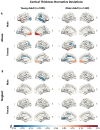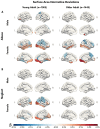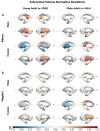This is a preprint.
Childhood Maltreatment and Deviations from Normative Brain Structure: Results from 3,711 Individuals from the ENIGMA MDD and ENIGMA PTSD
- PMID: 40661416
- PMCID: PMC12258881
- DOI: 10.1101/2025.06.04.657717
Childhood Maltreatment and Deviations from Normative Brain Structure: Results from 3,711 Individuals from the ENIGMA MDD and ENIGMA PTSD
Abstract
Childhood maltreatment (CM), encompassing abuse and neglect, affects over two-thirds of the general population and increases risk for stress-related psychopathology, including major depressive disorder (MDD) and posttraumatic stress disorder (PTSD). The extent to which neuroanatomical alterations in MDD and PTSD are attributable to CM, however, is uncertain. Here, we analyzed CM and 3D structural brain MRI data from 3,711 participants in the ENIGMA MDD and PTSD Working Groups (25 sites; 33.3±13.0 years; 59.9% female). Normative modeling estimated deviation z-scores for 14 subcortical volumes (SV), 68 cortical thickness (CT), and 68 surface area (SA) measures, capturing differences from population norms. Transdiagnostic associations between CM and brain deviation scores were evaluated within each sex and age cohort. In young adults (ages 18-35), abuse was associated with larger volumes in thalamus and pallidum, thinner isthmus cingulate and middle frontal regions, and thicker medial orbitofrontal cortex; there were no significant effects in pediatric (≤18 years) participants. The strongest effects were observed in young female adults (∣β∣=.07-.22, q<.05): greater abuse and neglect were correlated with smaller hippocampus and putamen volumes, thinner entorhinal cortex, and smaller SA in fusiform/inferior parietal regions, and with larger SA in orbitofrontal and occipital cortices. In males, abuse had widespread effects on CT and SA (∣β∣=.1-.18, q<.05); effects for neglect were minimal. Our findings of age- and sex-specific instantiations of CM on brain morphometry highlight the importance of developmental context in understanding how adverse experiences shape neurobiological vulnerability to MDD and PTSD.
Keywords: Brain morphometry; Childhood maltreatment; Depression; Normative modeling; PTSD; Sex differences.
Conflict of interest statement
Conflicts of Interest Disclosures CA served as a consultant and on advisory boards for Douglas Pharmaceutical, Freedom Biosciences, Aptinyx, Genentech, Janssen, Psilocybin Labs, Lundbeck, Guidepoint, and FSV7. He also received royalties from a patent for using mTORC1 inhibitors to augment the effects of antidepressants. IHR reports research funding from BI Pharma on precision psychiatry. RH is a consultant for Jazz Pharmaceuticals. LL reports unpaid membership on the Scientific Committee for the International Society for the Study of Trauma and Dissociation (ISSTD) and spousal IP payments from Vanderbilt University for technology licensed to Acadia Pharmaceuticals and spousal private equity in Violet Therapeutics unrelated to the present work. EAO reports employment at Crisis Text Line. KR has performed scientific consultation for Bioxcel, Bionomics, Acer, and Jazz Pharma; serves on Scientific Advisory Boards for Sage, Boehringer Ingelheim, Senseye, and the Brain Research Foundation, and he has received sponsored research support from Alto Neuroscience. AE reports salary and equity from Alto Neuroscience, equity from Mindstrong Health and Akili Interactive. TY reports a clinical trials agreement that provides funds to UCSF by NeuroQore, and a portion of these funds to UCSF have supported TTY’s effort on paper(s) with NeuroQore. None of the funds from NeuroQore supported Dr Yang's effort on this current paper. All other authors do not have any conflicts of interest to declare.
Figures



References
-
- Cuijpers P., et al. , The disease burden of childhood adversities in adults: a population-based study. Child Abuse Negl., 2011. 35(11): p. 937–945. - PubMed
Publication types
Grants and funding
- K01 MH122774/MH/NIMH NIH HHS/United States
- R01 MH131532/MH/NIMH NIH HHS/United States
- R01 MH127176/MH/NIMH NIH HHS/United States
- R21 MH098198/MH/NIMH NIH HHS/United States
- R01 MH129742/MH/NIMH NIH HHS/United States
- R21 MH130817/MH/NIMH NIH HHS/United States
- K99 MH117229/MH/NIMH NIH HHS/United States
- WT_/Wellcome Trust/United Kingdom
- R61 AT009864/AT/NCCIH NIH HHS/United States
- R01 HL118181/HL/NHLBI NIH HHS/United States
- R01 AG058854/AG/NIA NIH HHS/United States
- R01 MH128371/MH/NIMH NIH HHS/United States
- R21 MH106998/MH/NIMH NIH HHS/United States
- R33 AT009864/AT/NCCIH NIH HHS/United States
- R01 MH111671/MH/NIMH NIH HHS/United States
- R01 MH106574/MH/NIMH NIH HHS/United States
- R01 MH132221/MH/NIMH NIH HHS/United States
- K23 MH101380/MH/NIMH NIH HHS/United States
- R21 MH102634/MH/NIMH NIH HHS/United States
- R00 MH117229/MH/NIMH NIH HHS/United States
- R01 GM121806/GM/NIGMS NIH HHS/United States
- R01 NS140256/NS/NINDS NIH HHS/United States
- K01 MH117442/MH/NIMH NIH HHS/United States
LinkOut - more resources
Full Text Sources
Miscellaneous
